Opslag of schijfruimte is de hoeveelheid data gemeten in “bytes” die een harde schijf kan bevatten. Mac gebruikers kunnen controleren hoeveel schijfruimte er beschikbaar is op hun systemen door te klikken op het Apple-menu linksboven in het scherm en “Over deze Mac” te selecteren, en vervolgens het tabblad “Opslag” te selecteren.
Desondanks kan zelfs basisinformatie in het begin verwarrend lijken, vooral met betrekking tot de categorieën harde schijven van de Mac. Mac gebruikers worden zich vaak bewust van de opslag/schijfruimte wanneer bij het downloaden van bestanden van het internet een bericht verschijnt waarin staat dat ‘er niet genoeg vrije ruimte is’.
Wanneer u de status van de opslagruimte op uw systeem controleert, valt u wellicht op dat de categorie “Overige” veel schijfruimte inneemt op uw Mac.
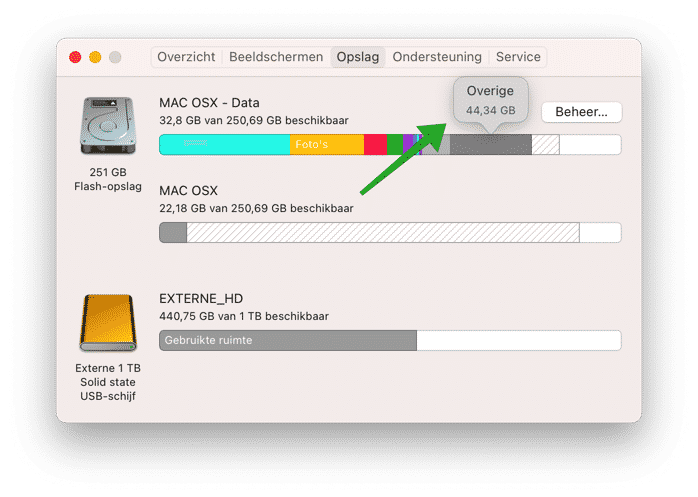
De categorie “Overige” bestaat uit bestanden wat we noemen cache, of tijdelijke bestanden. Dit zijn bestanden die op uw Mac worden aangemaakt door verschillende apps en Mac instellingen. Deze bestanden kunt u verwijderen met behulp van handige apps zoals CleanMyMac.
In dit artikel leg ik u uit hoe deze “Overige” cache bestanden kunt verwijderen uit uw Mac om schijfruimte vrij te maken.
Wat is overige opslag in Mac
De categorie overige opslag in Mac kan misleidend zijn. De overige categorie bevat namelijk niet alleen cache of tijdelijke bestanden maar ook persoonlijke bestanden. Zo bevat de overige opslag persoonlijke bestanden zoals PDF, afbeeldingsbestanden, documenten etc. Ook kan het bestanden bevatten die gecomprimeerde inhoud bevatten zoals ISO-bestanden, IMG-bestanden, ZIP-bestanden etc. Ook Mac bestanden worden omvat als “Overige” bestanden zoals iCloud-bestanden, schermprints gemaakt in macOS, lettertype-bestanden, applicatie plugins en extensies.
Kortom een hele hoop verschillende bestanden dus die aan veel verschillende apps gekoppeld zijn. Dit is nog maar een kleine lijst de Overige opslag categorie bevat nog meer soorten opslag.
Lees ook: (Artikel gaat hieronder verder)

Veel Mac gebruikers hebben te maken gehad met het bericht dat hun opstartschijf bijna vol is. Het uiterlijk…

Malware verwijderen Mac? Dit artikel bevat informatie en een stap voor stap instructie hoe u malware van uw…

Een goede werking van uw Mac is essentieel om zoveel mogelijk voordeel te halen uit de macOS Monterey…

Cache bestanden zijn voor veel gebruikers een doorn in het oog. Cache bestanden, met andere woorden tijdelijke bestanden…

Last van een trage Mac computer? Ook Mac computers worden op den duur traag door een overvloed van…
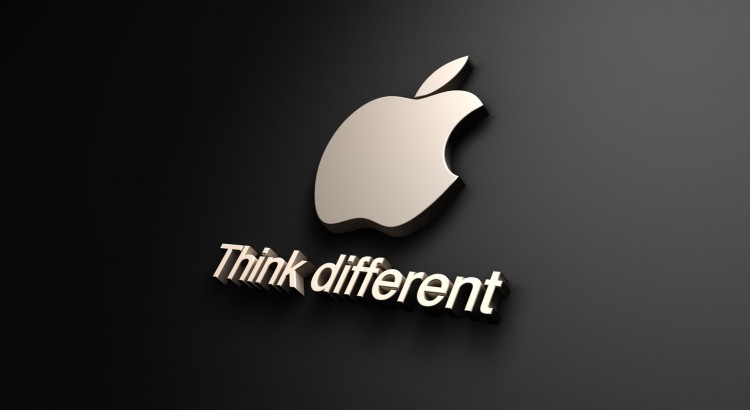
Het is bijzonder wat je allemaal met een Mac kunt doen. In dit artikel een aantal kleine tips…
Hoe verwijder ik Overige opslag in Mac
Een Mac besturingssysteem is vaak geoptimaliseerd om problemen zoals opslag problemen te voorkomen. Hiervoor is een handig hulpmiddel ingebouwd om uw Mac op te schonen en sneller te maken.
Het hulpmiddel heet Aanbevelingen en kan worden gestart door in de Opslag instellingen op de Beheer knop te klikken.
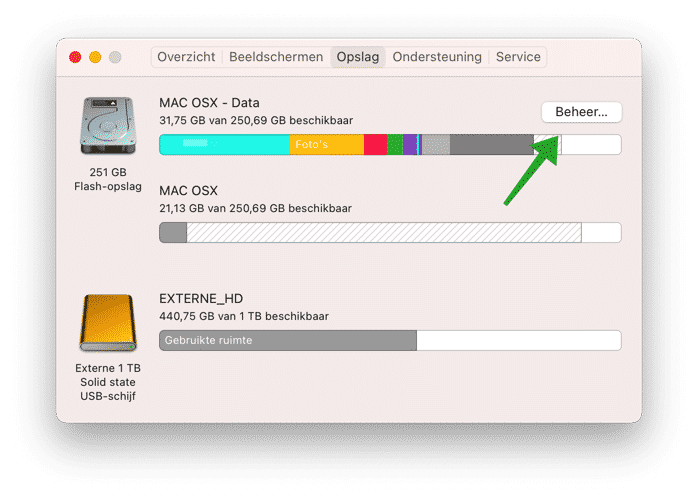
In de Aanbevelingen heeft u een aantal hulpmiddelen om Overige opslag om uw Mac te beheren. U kunt data en gegevens bewaren in iCloud. Bewaar alle bestanden, foto’s en berichten in iCloud en bespaar ruimte door alleen recente bestanden en geoptimaliseerde foto’s op deze Mac te bewaren als er opslagruimte nodig is.
Door Optimaliseer opslag in te schakelen kunt u ruimte bewaren door films en tv-programma’s die u al hebt bekeken automatisch van deze Mac te verwijderen.
Het automatisch legen van de prullenbak bespaart ook Overige opslag schijfruimte. Mocht u het vergeten om zelf de prullenbak te legen. Het alleen verplaatsen van bestanden naar de prullenbak is namelijk niet genoeg om opslag te besparen op uw Mac.
Schoon documenten op als u oude documenten wenst te verwijderen op uw Mac om opslag vrij te maken. Oude documenten in de Documenten map kunnen veel opslag in beslag nemen en het periodiek opruimen van deze map is aan te raden.
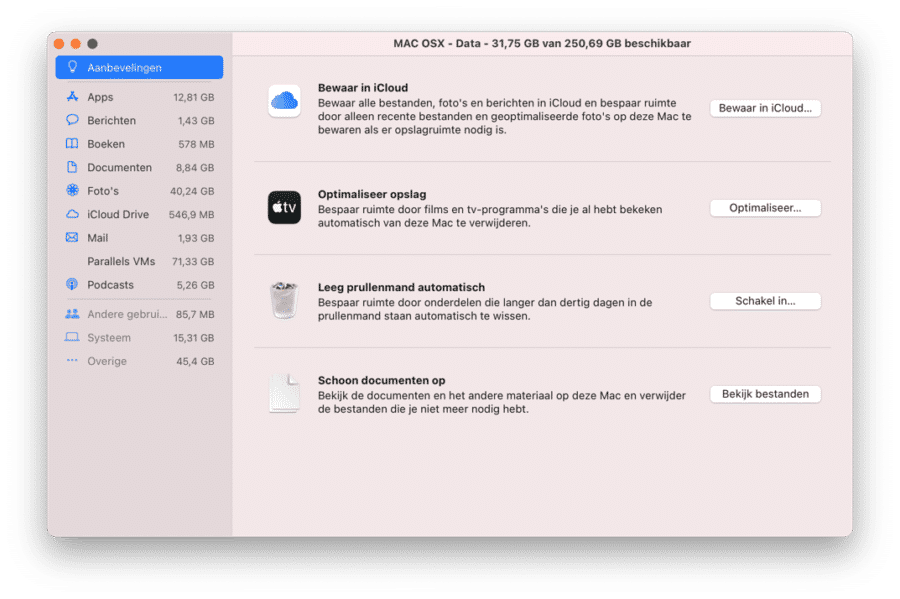
Cache bestanden verwijderen
Zoals al eerder aangegeven in de intro tekst. De Overige opslag op uw Mac bestaat ook voor een deel uit cache bestanden.
Cache bestanden zijn tijdelijke bestanden die uw Mac computer downloadt en opslaat om in de toekomst tijd te besparen. Wanneer u bijvoorbeeld een website bezoekt, downloadt uw browser de afbeeldingen en slaat ze op in een cache-map. De volgende keer dat u de site bezoekt, laadt uw browser de gegevens snel vanuit de cache in plaats van ze opnieuw te downloaden. Tot de in de cache opgeslagen gegevens behoren bestanden, afbeeldingen, video’s, scripts en andere multimedia.
Niet alleen uw browser slaat bestanden in de cache op. Ook andere apps, zoals foto- en videobewerkingssoftware, maken gegevens in de cache aan. Zelfs de eigen apps van Apple, zoals Spotlight en Kaarten, en macOS zelf slaan bestanden in het cachegeheugen op. Er zijn drie hoofdtypen caches: browsercache, systeemcache en applicatie-cache (ook wel gebruikers-cache bestanden genoemd).
Door de cache te wissen, verwijderd u onnodige gegevens en maakt u schijfruimte vrij. Maar is het wel een goed idee om al die cachebestanden te verwijderen?
Hoewel u met cachebestanden afbeeldingen en andere elementen op pagina’s sneller kunt laden als u bekende sites opnieuw bezoekt, heeft u de opgeslagen gegevens in de cache meestal niet nodig. Denk eens aan elke website die u ooit online hebt bezocht – elke webshop, elk social media-profiel, elke zoekopdracht. Dat zijn een heleboel afbeeldingen en video’s die op uw Mac computer zijn opgeslagen, en waarschijnlijk geeft u de meeste van die websites geen tweede bezoek.
En dat is alleen nog maar de browsercache – er is ook nog de systeem- en applicatie-cache. Als u het cachegeheugen nooit hebt opgeschoond, kunt u gigabytes aan onnodige bestanden hebben die ruimte innemen op uw Mac computer.
Het verwijderen van cache-bestanden kunt u op twee manieren doen. U kunt de cache-bestanden handmatig verwijderen voor iedere app OF u kunt een hulpmiddel inzetten om cache-bestanden op uw Mac automatisch te laten verwijderen.
Handmatige cache bestanden verwijderen van uw Mac
Open Finder. In het menu bovenin klik op Ga en daarna Ga naar map. In het venster type:
~/Bibliotheek/Caches/
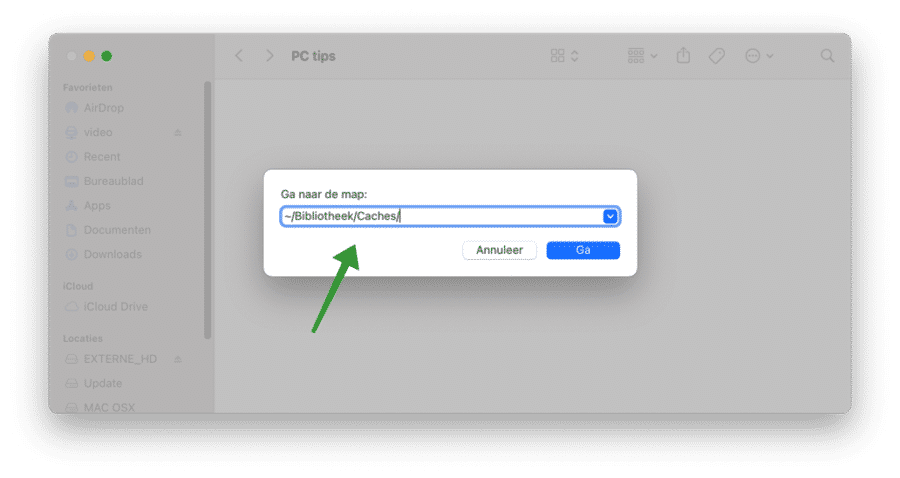
De map met cache-bestanden op uw Mac wordt nu geopend. Hier ziet u een hele lijst van apps geïnstalleerd op uw Mac en hun bijbehorende tijdelijke cache-bestanden. Selecteer de cache die u wenst te verwijderen en klikt op verwijderen.
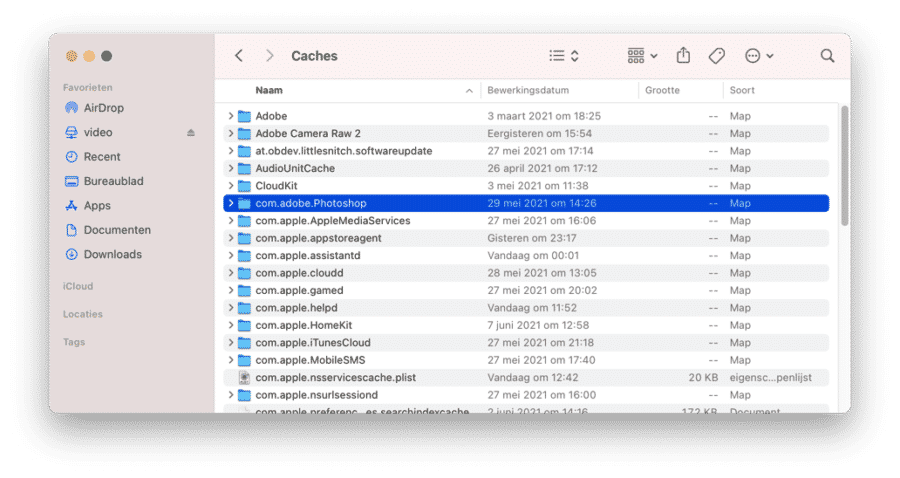
Ik kan voorstellen dat u geen enkele idee heeft welke cache u wenst te verwijderen. Het is daarom handiger om een hulpmiddel in te zetten om de cache-bestanden op uw Mac te verwijderen en Overige opslag vrij te maken op uw Mac.
Automatisch cache-bestanden verwijderen op uw Mac om Overige opslag vrij te maken
De snelste en simpelste manier om cache-bestanden te verwijderen is door gebruik te maken van CleanMyMac.
In het linkermenu klik op Systeembestanden. Klik daarna op de Scan knop om tijdelijke bestanden op uw Mac te detecteren.
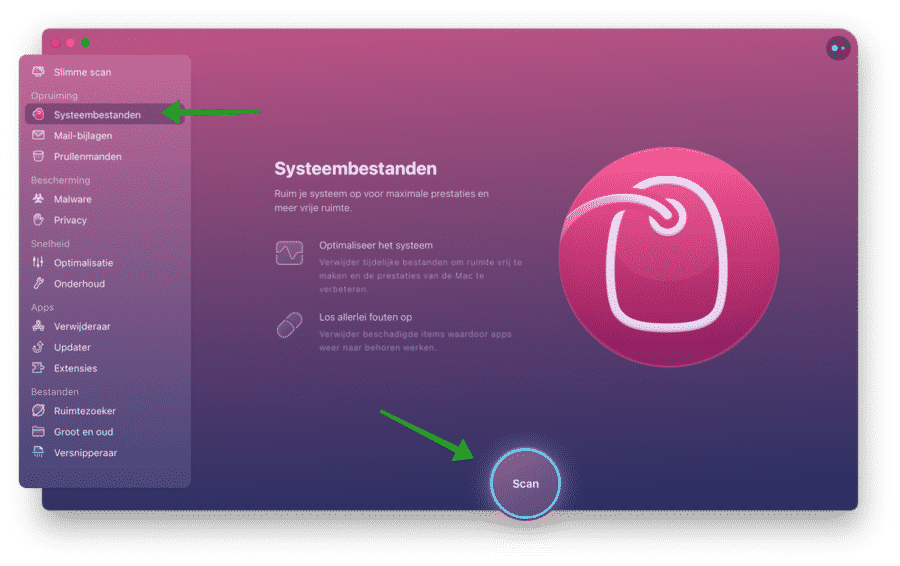
Er wordt nu een overzicht getoond van de gevonden cache-bestanden op uw Mac. Dit zijn gebruikerscachebestanden, systeemcachebestanden, taalbestanden, systeemlogs, en gebruikerslogs. Klik op de Ruim op knop om de verschillende cache bestanden definitief te verwijderen van uw Mac.
Geen zorgen deze bestanden kunt u allemaal veilig verwijderen.
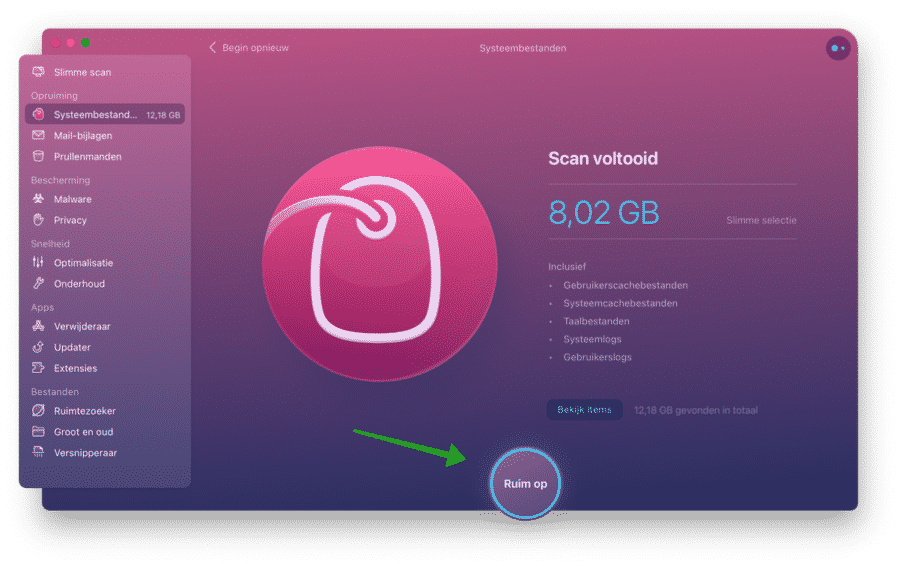
Systeem opruimen, dit duurt niet lang.
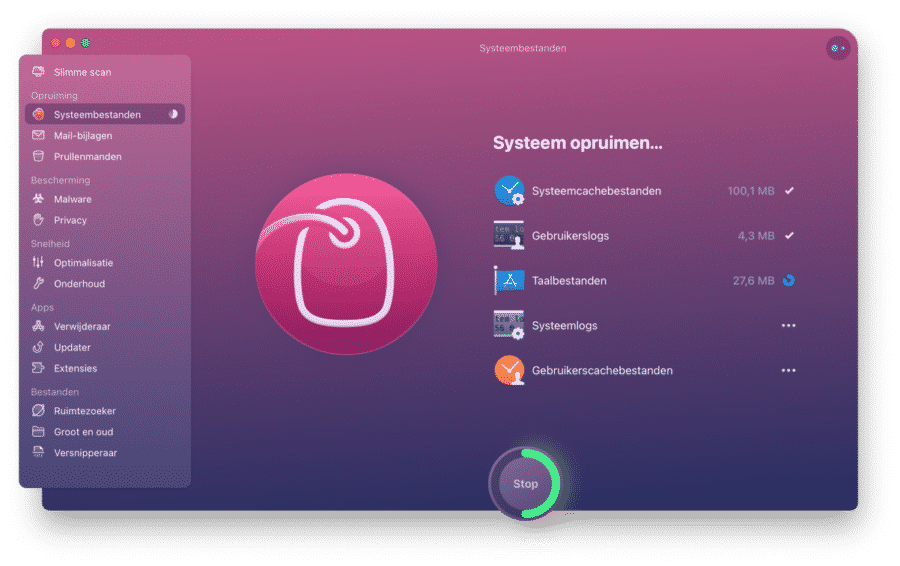
Als de opruiming van Overige opslag is voltooid dan ziet u in het overzicht hoeveel gigabytes aan opslag er verwijderd is van uw Mac.
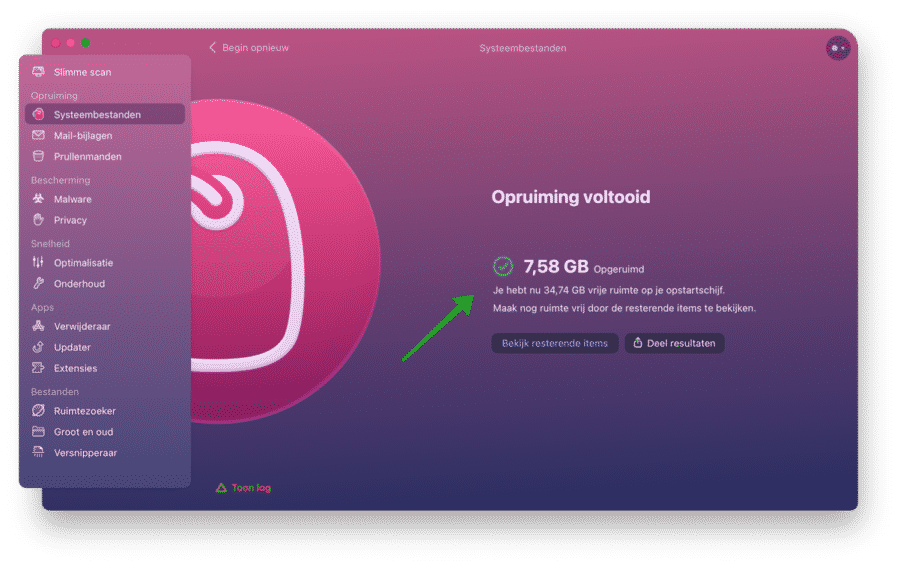
Lees meer tips om uw Mac sneller te maken.
Ik hoop u hiermee geholpen te hebben. Bedankt voor het lezen!
Meld u gratis aan en word lid van ons nieuwe PC Tips forum.


Hallo Stefan, Ik heb op mijn MacBook Air (13-inch, Early 2014) OS 11.7.10 onder overige opslag na je tips nog zo’n 58GB aan data. Al jaren staat CleanMyMac X geïnstalleerd en scan daarmee het systeem en zojuist ook weer de cache opgeruimd. Onder handmatige cache zie ik niet zo veel meer staan helaas. Is er nog een manier om echt in “Overige” te kijken wat daar nog in zit, aangezien het grijs is beheer kan ik er niet in kijken ….. Thanks en groet, Herman
Hallo, ik heb geen aanvullende tips en kan ook niet meekijken, omdat ik macOS 11.7 niet heb draaien. Het zouden net zo goed timemachine back-ups kunnen zijn, omdat het om zoveel data gaat. Eventueel kunt u de toetsencombinatie Command + Shift + . gebruiken om verborgen bestanden te tonen in Finder. Soms verbergen deze bestanden aanzienlijke hoeveelheden data. mvg
Ik ergerde me kapot aan “overige opslag”. Na dit advies is het me gelukt de overige opslag te verwijderen van mijn Mac. SUPER!!
Fijn dat het is gelukt! Bedankt voor uw reactie. Groet, Stefan
Het is gelukt, dankjewel
Fijn dat dit artikel heeft geholpen. Bedankt voor uw bericht. Groet, Stefan
Bedankt he, erg duidelijk.
Fijn dat het heeft geholpen. Bedankt voor uw bericht!
Dankjewel, het is gelukt om de overige opslag te verwijderen!!
Fijn dat ik kon helpen. Bedankt voor uw reactie!